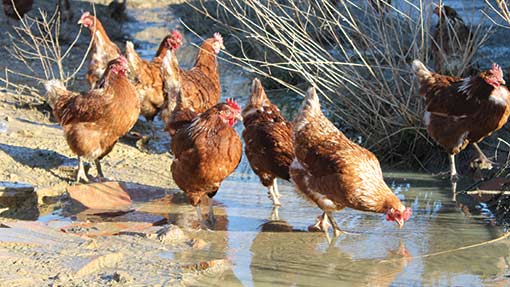Poultry producers fight for dry, clean ranges

Farmers across the UK have endured one of the wettest winters on record, leaving swathes of land under water, and the rest at saturation point.
For free-range poultry producers that has considerable health and welfare implications, so what can they do to minimise the damage?
According to Richard Turner, a vet with St David’s poultry team in Exeter, Devon, the impact of wet weather on bird health can be significant. “Birds that are out on the range love to drink dirty water, and flood water can bring faecal contamination from other farms on to the range,” he says.
“There is a risk of nasty bacterial infections, like E coli and erysipelas. The birds may also suffer from gut disturbances that could result in non-infectious enteritis, which will not only cause egg contamination, but can also reduce productivity due to poor food digestion.”
Another risk is when birds don’t want to range due to the bad conditions, says Mr Turner. “If they’re cooped up indoors they will get more fractious, which can increase levels of feather pecking and cannibalism. In addition, higher levels of stress can make them more prone to E coli and peritonitis.”
Mr Turner recommends using perforated plastic matting on the range, which can be fenced off to create a runway to fresh range areas, rotated in a form of strip grazing. “It is also sensible to consider worm burdens, as at any other time.”
Drainage
Roger Gent, chairman of the British Free-Range Egg Producers Association, says the key to keeping the birds and house clean and dry is to drain land immediately outside the popholes.
“We just go around with a spade and dig culverts to drain wet areas and puddles, particularly within 20ft of the house,” he says. “The biggest threat is birds drinking dirty water, and treading mud back into the shed – if you can keep the area around the house dry it’s a big help.”
Mr Gent, who keeps 21,000 free-range layers at Beedon Common, Newbury, Berkshire, also recommends putting slats, stone, or wood chippings around the house to keep the immediate area dry.
“Really, you can use whatever comes to hand. We dug a French drain, and used a membrane with a stone area over the top; it’s all a case of doing it at a price that’s acceptable, and using materials that are close by. But be careful of building waste, because of the risk of contamination – and don’t use road planings as the tar is toxic.”
Inside the house, Mr Gent recommends increasing the ventilation to try and alleviate the damp conditions. “When it’s wet inside you get a build-up of ammonia; generally it’s alright during the day as the popholes are open, but come back an hour after shutting them up, and check the ammonia levels then,” he says. “You may just need to put one fan on manually to keep drawing the air through.”
Fresh straw
Steve Clout, feed and pullet specialist at Humphrey Feeds, recommends putting straw or shaving bales in the houses, and allowing the birds to peck at and spread the fresh litter themselves. “Not only will this keep the birds entertained, but it will improve the litter as well.”
Producers could also increase the temperature in the house slightly, to dry out damp litter, and put straw bales around the outside of popholes to protect against wind and rain, he adds.
Where farmers have areas of the range completely under water, they should fence it off, and consider rotating paddocks quickly to minimise poaching. “Management of the range now is key to how it will regrow in the summer, so improve the drainage as much as possible, and if you can, move the birds once a week to give the grass root structure a rest.”
A number of farmers are experiencing an increase in second quality eggs due to muddy toe prints, but there is a more serious concern arising, he adds. “The high water table is flushing pathogens like erysipelas out of the soil, which is increasing mortality. And worm burdens are another problem – it’s difficult to prevent birds from drinking dirty water, so the only option is to put wormers into the feed.”
